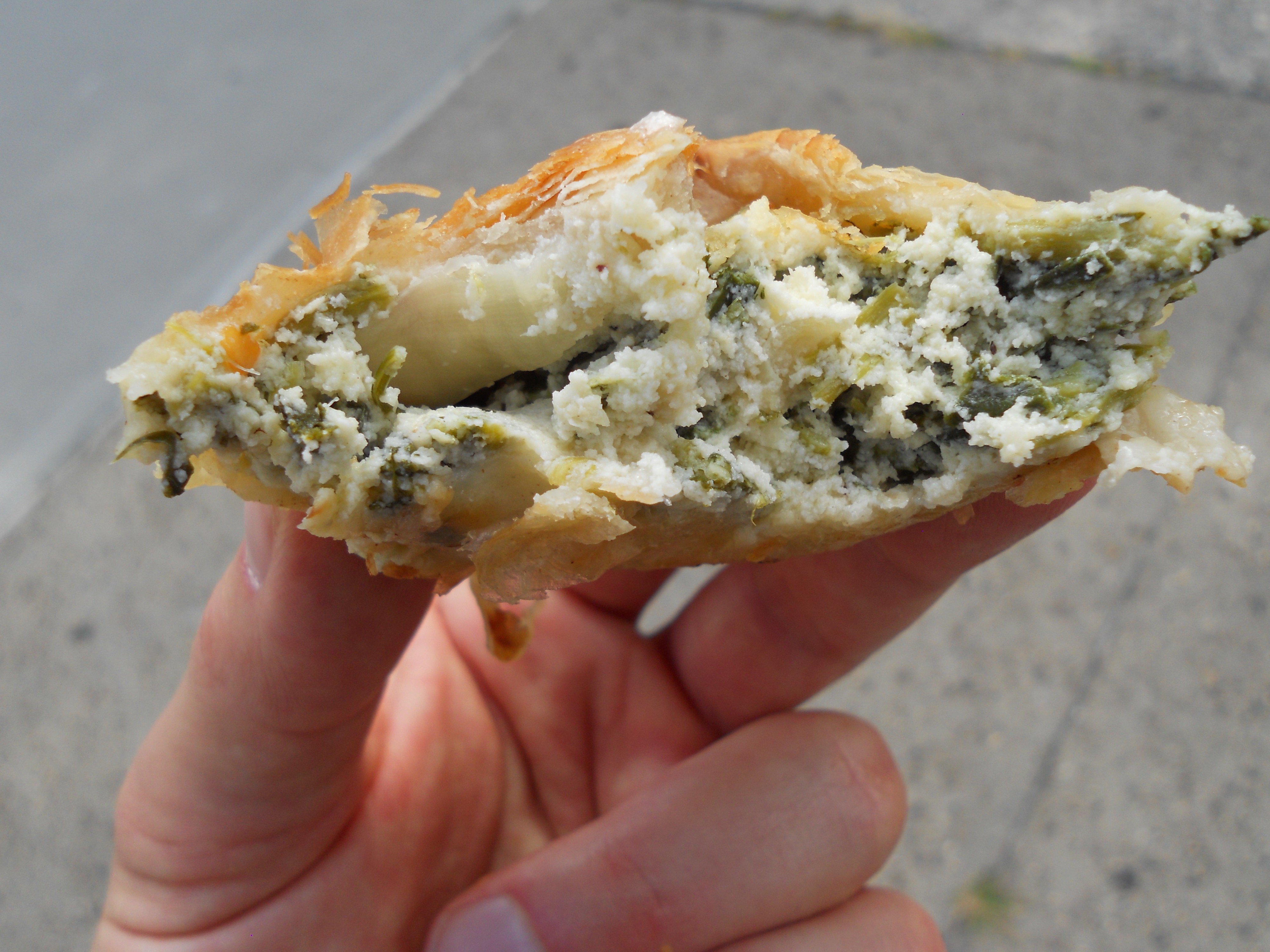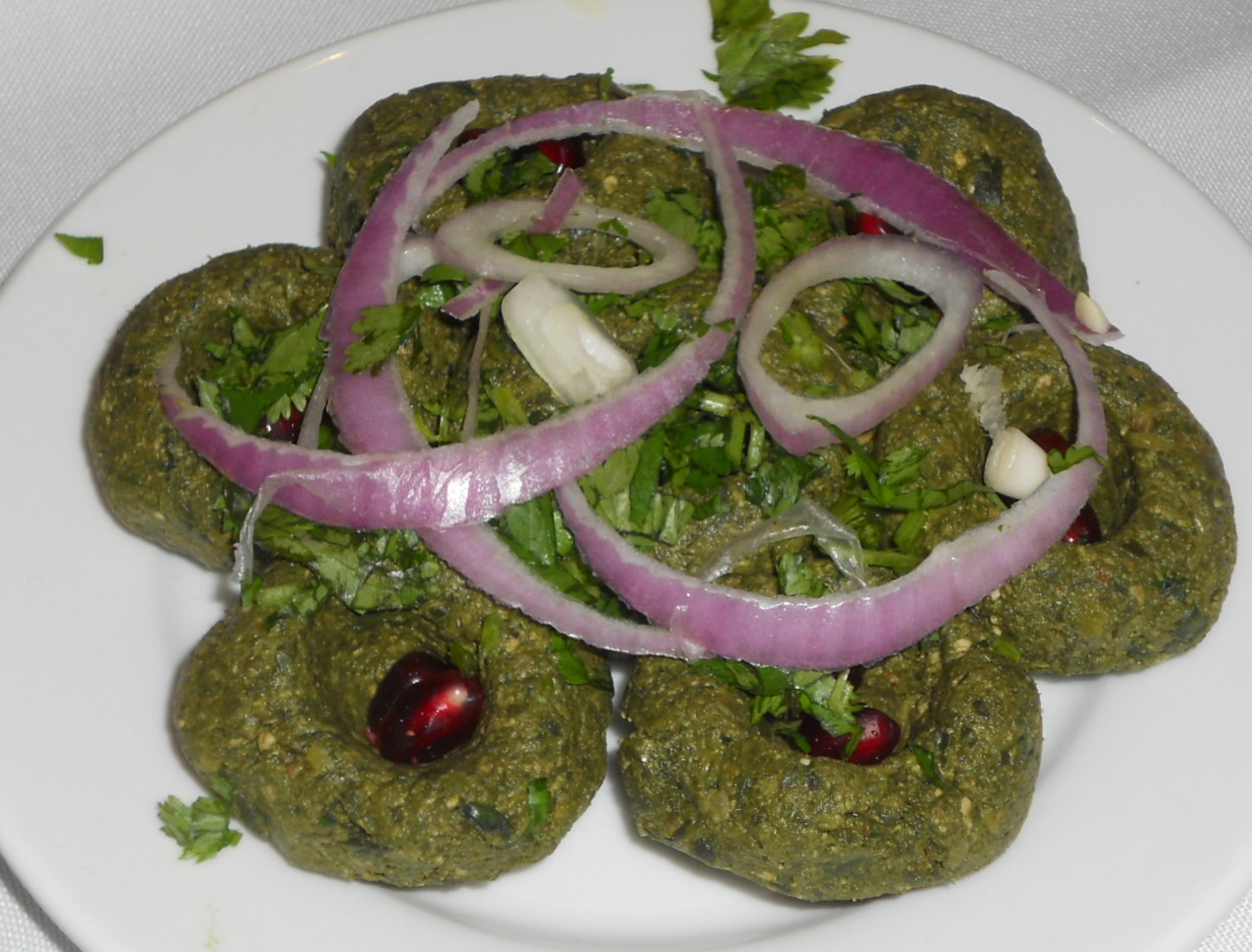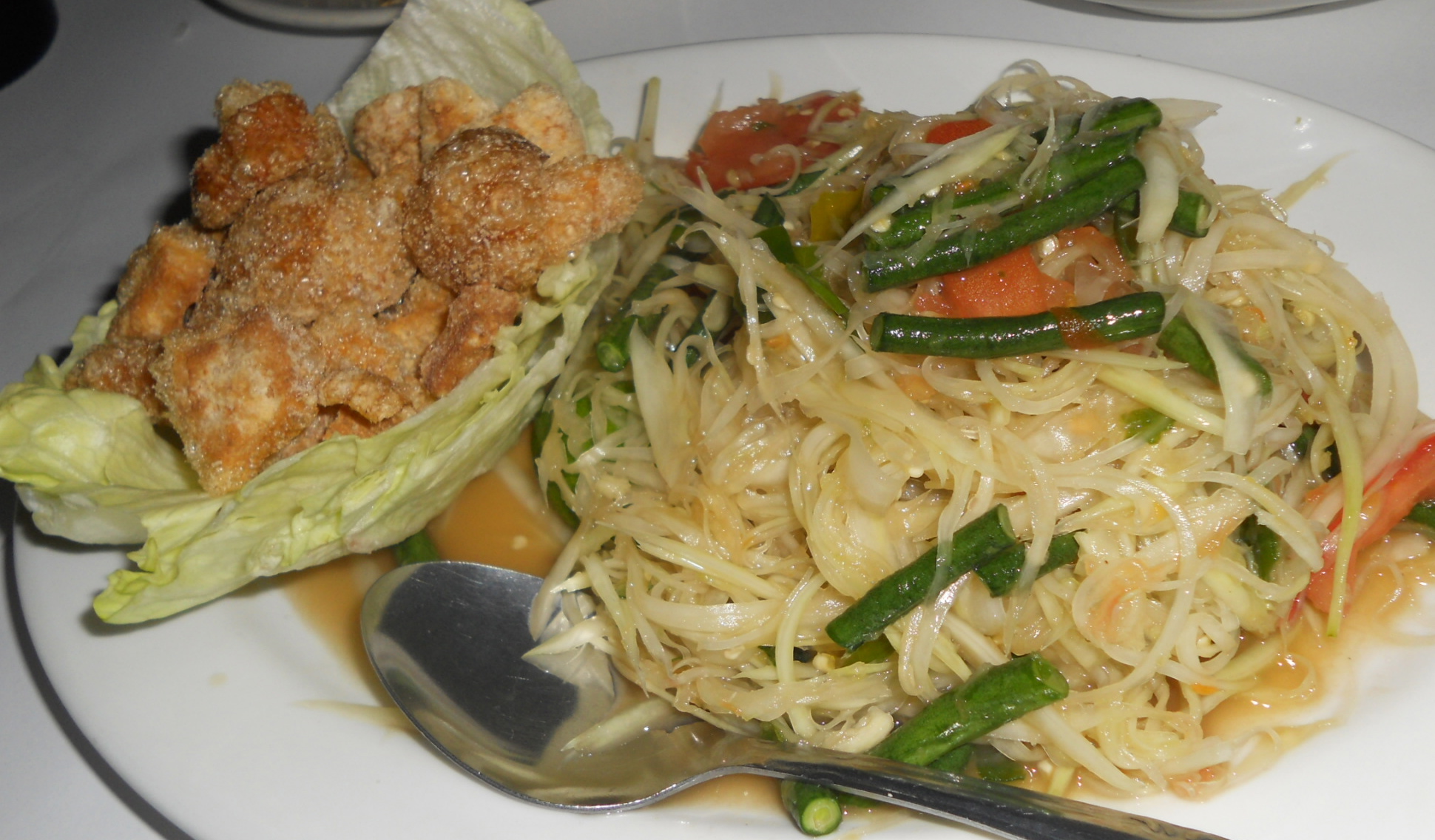|
|
 Apparently, this type of European mousey is delicious when coated with honey and poppy seeds... but wouldn't the honey and poppy seeds dreadlock his fur? Whenever I hang out with Slovenians, I learn something interesting. As I sat around Café Marlene, a Slovenian-owned spot in Sunnyside, my Slovenian companions started reminiscing about their favorite Slovenian meals, which did not include Icelandic putrefied shark. Their favorite Slovenian dishes did, however, include dormouse stew called obara, which is apparently a delicacy consumed only in the diminutive nation of Slovenia.
A dormouse is Europe’s outdoor version of a North American apartment mouse, except that the European variety is much fluffier, almost like a runty, short-tailed squirrel. Apparently, dormice are also tastier than squirrels. In ancient Rome, roasted dormice were considered a delicacy; they were raised in special enclosures, and served with a coating of honey and poppy seeds. (Yes, you read that correctly.) In the Middle Ages, dormice fell out of favor among the European elite, and were eaten only by desperate peasants.
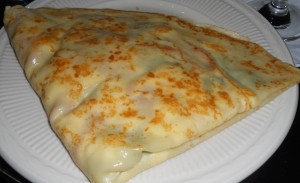 Slovenian palacinke... without dormice, honey, or poppy seeds Today, dormice are consumed only in Slovenia, but not necessarily by desperate peasants. One of my Slovenian friends is the daughter of a renowned Slovenian dormouse hunter, who managed to catch enough dormice to make a full-length coat for his wife and several Russian-style hats for his friends and family. Also, dormouse lard supposedly has healing properties, and is applied to the skin in an effort to heal bruises, rheumatism, and upset stomach. I am not making any of this up.
Café Marlene, owned by a pair of Slovenian sisters, serves some hearty Slovenian-style crepes (palacinke) … but alas, roasted Slovenian dormouse is not among the available ingredients. You can, however, get your choice of prosciutto, ham, spinach, roasted red peppers, pesto, feta cheese, bresaola, emmentaler cheese, tomatoes, or smoked salmon in your palacinke.
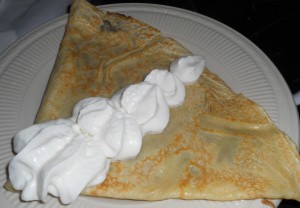 dessert crepe with chestnut cream... wait a sec, is honey-dipped dormouse considered an entree or a dessert? They’re everything you could possibly want from a crepe: fluffy, soft and thin, all at once. Café Marlene’s desserts are also fantastic, if not typically Slovenian—we inhaled a nutella-smeared croissant, a slice of pear tart, and crepes stuffed with a shockingly amazing chestnut cream spread.
I don’t get to say this very often in NYC, but Café Marlene is one of those rare, unhurried places where there is absolutely no pressure to eat and run. You can sit around all night, drinking wine or tea or espresso, and nobody would ever think about looking at you funny, even if you stay past closing time.
Despite the limited menu and limited seating, Café Marlene is an unusually loveable NYC spots where time seems to stop. Now if they could only add some roasted dormouse to the menu, I might be fully in love.
 I somehow don't think that this American mousey would be all that tasty in a crepe, but it sure was fun to stick him on a train to Flushing. 
Cafe Marlene
4111 49th Street, Sunnyside, Queens
Subway: 46th-Bliss (7 train)
|
|
|
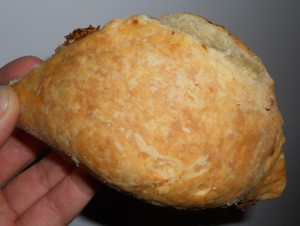 codfish patty, without the aquarium Some things never sound all that good, no matter how you try to describe them. Take, for example, pickled herring (gooey but oddly delicious), goat meat (stringy, but I swear that it’s a good sort of stringy), or Korean gelatinous fish skins. Or codfish patties, which sound like something you might find while cleaning the bottom of your pet cod’s aquarium.
But really, codfish patties are deceptively tasty. Especially the fresh-baked codfish patties served at Saint Vincent Bakery (formerly known as Vincie Bakery) in the Flatbush neighborhood of Brooklyn. The patties are made with spicy, dry shredded salt cod—slightly chewy, with bits of onion, hot pepper, and unidentifiable bits of green herbs—folded into a pocket of flaky dough that splits the difference between an empanada and a stuffed croissant. Great stuff for $1.50 per patty. The bakery also sells some excellent, inexpensive currant and coconut rolls ($1-$2, depending on the flavor).
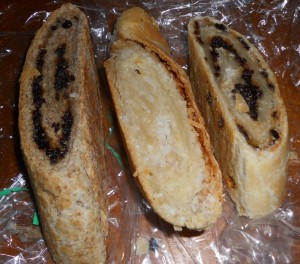 currant and coconut rolls, also without the aquarium or the fish droppings And in case you’re wondering, Saint Vincent and the Grenadines is a tiny, independent country in the Caribbean, not too far from Barbados, Saint Lucia, and Grenada. The total population of Saint Vincent and the Grenadines is around 120,000 souls, mostly concentrated on the relatively large island of Saint Vincent; the smaller Grenadines islands have a total population of 9,200, which is less than an average block in Manhattan. Sounds much nicer than Manhattan.
Saint Vincent and the Grenadines should not be confused with Grenada, a completely separate Caribbean nation of around 110,000 people. The nation of Grenada also encompasses a few of the sparsely populated Grenadine islands, but the larger island of Grenada is not technically part of the Grenadines (got that?). Grenadine, the pomegranate syrup used in Shirley Temples and other terrifyingly sweet cocktails, has nothing to do with either place; “grenadine” is derived from the French word for pomegranate. And pomegranates are not native to the Grenadine islands nor Grenada.
Confused? OK, good. I’ll stop now.
Anyway, the bakery named after the nation of Saint Vincent and Grenadines also serves food from the country of Grenada. But only on Saturdays. At long last, I get to try oildown!
As mentioned in an earlier post about Bahamian food, oildown sounds like something sexy that may or may not happen to you on a beach in Grenada. It’s also the national dish of Grenada, made from breadfruit, meat, and vegetables that have been simmered in coconut milk for hours and hours. When the dish is finished cooking, only a coating of coconut oil remains on the meat and veggies. I always thought that sounded ridiculously awesome.
 pretty sexy, no? And it was ridiculously awesome, once I finished startling the friendly Grenadian servers. I don’t think they were expecting a little white dude to walk into a bakery in Flatbush and order a dish that doesn’t appear anywhere on a sign or a menu. One of the friendly ladies behind the counter (presumably one of the chefs responsible for the oildown) stopped dead in her tracks when I ordered oildown, gave me a quizzical look, and said, “Oildown?!? What you know ‘bout oildown?!?” And then she laughed as if I’d just told a really great joke, and disappeared into the kitchen.
A couple of minutes later, the friendly Grenadian chef/server reemerged from the kitchen with a large Styrofoam container, jammed with meat and vegetables in a bright yellow sauce. She helpfully described the contents of the container: carrots, breadfruit, yucca, green plantains, pig tails, some chunks of chicken, and a dribble of okra. And we all know that nothing dribbles like okra.
The oildown was filled with pleasant surprises… and isn’t that exactly what you would want from any oildown, culinary or otherwise? The coconut flavor was far less intense than I’d expected, and the dish was nowhere near as oily as the name might suggest. But the pig tails were absolutely delicious—apparently, pigs reserve their most intense ham flavors for their tails. Good job, pigs.
The other revelation was the breadfruit, which tasted like… well, bread. Or bread dough, to be specific—it reminded me of a crustless bread that had been pressed into an impossibly dense, flat patty. As a card-carrying carb lover, I was in heaven.
As heavenly as the breadfruit was, it’s still hard for me to believe that the pigtail-spiked oildown was as heavenly as having a gorgeous Grenadian give you a full-body oildown on a Grenadian beach… but I wouldn’t really know, unfortunately. And it was probably as close as you can get to Grenadian heaven without leaving Flatbush.
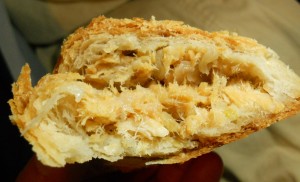 See? Codfish patties are definitely not something you find after your pet cod drops a deuce. 
St. Vincent Bakery
1721 Nostrand Ave., Brooklyn
Subway: Beverly Ave. (2, 5 trains)
|
|
|
Most of the time, I focus my food blogging energy and digestive juices on obscure ethnic eateries in NYC. But once in a while, I run across amazing food in unexpected places–like Des Moines, Iowa or Talkeetna, Alaska–and I feel obligated to share my surprise (and smelly belches?) with the world.
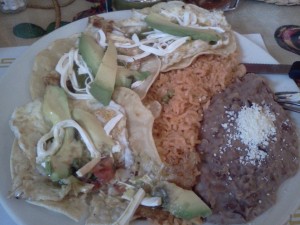 who knew that you had to travel to the 'burbs to get great Mexican food in NY? My lovely naked fiance and I visited the Rockland County “village” of Haverstraw–just north of Nyack along the Hudson River–for a three-day break from NYC. We’d never been to Haverstraw, and figured that we’d stay in a fantastic B&B, spend our days hiking at High Tor and Hook Mountain, and then eat overpriced pretentious Hudson Valley yuppie food at night. I hate overpriced pretentious yuppie food, but I figured that it would be an acceptable sacrifice, if it meant that we could spend some time away from the mayhem of the city.
And guess what? I had it all wrong. Haverstraw, formerly known as the brickmaking capital of the world, is a mostly working-class town, featuring a gravel mine and a gigantic oil-fired power plant. No silly, pretentious food here. Not even in the prettiest cafe in town.
For our first Haverstraw food shock, we stopped by a seven-table tacqueria called Tacos Marianita, thinking that we’d enjoy another mediocre east-coast burrito. Nope. This was roughly my 200th attempt at eating Mexican food in NYC and DC, and I finally found a spectacular plate of huevos rancheros, a jaw-droppingly tasty green salsa, shockingly fresh horchata, and the best chicken mole I’ve eaten east of the Rockies. In a Rockland County restaurant with exactly zero yelp reviews. Huh?
 Peruvian seco norteno, portioned for non-yuppie appetites And just to keep the Latin American hits rolling, we spotted a Peruvian restaurant called Maura’s Kitchen on our way through Nyack the next afternoon. We raided the steam table for a massive plate of roasted chicken with cilantro rice and canary beans, along with an equally massive plate of seco norteno, absurdly tender beef stewed in cilantro sauce. We washed the whole mess down with a gigantic glass of fresh chicha morada, a lightly fermented punch made from pinapple, lime, and purple corn–already one of my favorites from a previous visit to a Peruvian restaurant in NYC. The crazy thing? The food might have been every bit as good as the stuff I ate at Urubamba, my favorite spot in Queens. Huh?
In an attempt to recover from our shock at finding such great Peruvian and Mexican food in the Hudson Valley ‘burbs, we ducked into a place called Bella Rose Cafe. We weren’t hungry. We just wanted to soothe our bulging bellies with a bottle of wine.
And completely by accident, we found my new favorite New York Italian restaurant.
Here’s the thing: Bella Rose Cafe is a gorgeous place, with exposed Haverstraw brick and high ceilings and classy artwork and artfully chosen music… and places that look like Bella Rose usually serve overpriced pretentious food. And I hate overpriced pretentious crap.
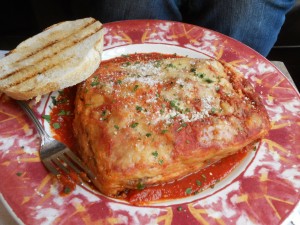 if this piece of lasagna was located in Manhattan, we could probably rent it out as an apartment for $2000 month But don’t be fooled by the classy decor. The friendly, charismatic brothers who own Bella Rose serve their Italian grandma’s recipes, and every platter of food is designed for the appetite of a hulking bricklayer. The meatballs and grilled polenta border on divinity, and most of the desserts–espresso brownies, nutella cake, and fresh biscotti, among other delights–are baked onsite by the owners’ Italian mom. The lasagna is probably the best I’ve ever eaten, and the “regular cut” is roughly the size of my Manhattan apartment; for $2 extra, you can order “John’s cut”, which includes a gigantic meatball and is probably the size of my mother’s farm in Iowa. If you leave Bella Rose Cafe hungry, you screwed up.
The craziest thing is that the prices are incredibly reasonable. Sandwiches (including an Italian grilled cheese with prosciutto and red peppers) start at $6.95; most of the (gigantic) entrees range from $9 to $15, including prosciutto-spiked asiago mac-and-cheese for $8.95 or an epic platter of lasagna for $14.95, including salad or a cup of soup. The beer/wine/liquor options are carefully chosen and inexpensive–a great bottle of pinot grigio from a small Italian vineyard costs less than $25. There’s a happy hour with $2.50 beers, and a creative array of liquor-spiked coffee drinks for $7. We ate there three times in less than 48 hours. It was that good.
Maybe I’ve been ruined by Manhattan, but nothing about Bella Rose seems normal to me. You can sit around drinking a cup of non-overpriced coffee all day, or you can get bombed on excellent-but-inexpensive wine, or gorge yourself silly on some amazingly inexpensive homemade Italian food. And no matter what, nobody is going to look at you funny for occupying a table for several hours. If anything, they’ll treat you like family if you hang out all day. That’s not normal. And that’s a huge compliment.

Bella Rose Cafe
11 New Main Street, Haverstraw, NY

Tacos Marianita
10 West Street, Haverstraw, NY

Maura’s Kitchen
248 Main Street, Nyack, NY
* Maura’s Kitchen is now offering food-friendly events! Check out their new website at http://www.mauraskitchenpresents.com/.
|
|
|
Some food fads really need to die. Take wheatgrass shots, for example. I don’t dislike the stuff, but much of the world is convinced that it’s, like, the most miraculously awesome-est thing you could ever put into your body.
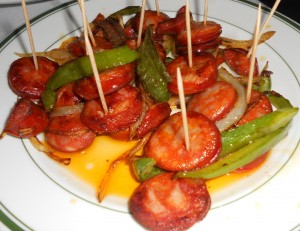 no need to worry about grassy toxins when you have a huge hunk of Spanish sausage in your mouth But once upon a time, a group of six extremely health-conscious business tycoons (co-owners of a firm with $550 million in annual revenues) went to the doctor to get a physical, as required by their insurance policies. The six health-conscious rich dudes knew that a daily shot of wheatgrass was good for them. So they figured that massive mugs of wheatgrass would be even better for them, and they instructed their personal chefs to prepare Super Big Gulps of wheatgrass juice, several times a day.
And guess what? The health-conscious, fad-embracing, wheatgrass-guzzling tycoons all failed their physicals. (The seventh business partner, an overweight old dude who never exercises or eats vegetables, passed easily.) The health-conscious tycoons’ bloodwork revealed bizarrely elevated levels of a rare toxin that frequently appears in blades of grass, but not in humans. The doctor was completely confused: “Normally, this chemical is only found in livestock, but it’s toxic to humans. I can’t explain it. Have you guys, um, been eating grass or something?”
Like I said, wheatgrass is clearly a health fad that needs to die.
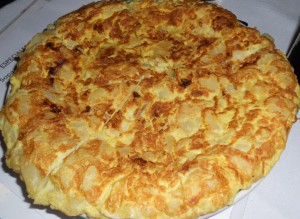 but anybody who sells $6 Spanish tortillas definitely deserves to live And while we’re on the topic of food fads that need to die… can we please stop worshipping faux-Spanish small plates restaurants? I just don’t understand why I would want to pay an assload of money for fancy small plates. I like big plates. Whenever I go to a trendy “Spanish” restaurant in the U.S., I get mad: $50 seems to get flushed down the drain far too quickly, sacrificed to the gods of pretentious fancy yuppie food that barely resembles anything you would find in Spain.
That’s not to say that I don’t love Spanish food. As long as it’s in Spain, where the tapas are usually intended as tasty, cheap accomplices to a long night of drinking tasty, cheap red wine. I have a foggy memory of a night spent guzzling red wine and nibbling olives, fresh bread, Serrano ham, and Spanish tortilla in a café in a small town in Cantabria. My bill came to about $6. I love you, Spain.
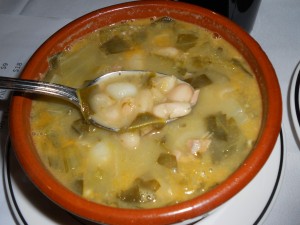 non-abused caldo gallego To my surprise, Casa Galicia in Astoria is far closer (spiritually, at least) to Spain than I expected. It’s a large, nondescript social club and restaurant, featuring the classic Astoria crowd of craggy old European dudes hunched over their drinks. But as soon as I glanced at the wine list, I knew that the place was blissfully non-pretentious: you can get a bottle of perfectly drinkable Spanish Rioja for $12. We decided to splurge on a $17 bottle. You could never write that sentence about any restaurant in Manhattan.
Most of the food was as cheap and tasty as the wine. We started with a full-sized tortilla ($6 for eight pieces), Spain’s always-excellent three-dimensional version of a potato omelet—and arguably the country’s national dish. We then chomped our way through a plate of Serrano ham with manchego cheese ($8), some delicious fried chorizo with onions and peppers ($5 for a surprisingly generous plate), another plate of manchego cheese with olives ($6), and some overcooked gambas al ajillo (shrimp stewed in garlic and butter, $10), which were the only disappointment of the evening.
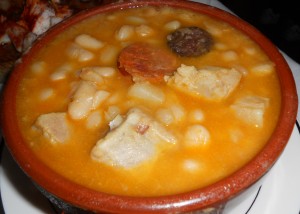 porky, non-abused fabada In a nod to the club’s Galician roots, we also tried the caldo gallego ($3), a reasonably appealing stew made from white beans, bits of ham, and plenty of collard greens. The fabada ($5)—a stew popular in neighboring Asturias—was even better, with large white beans in a deceptively creamy, pork-spiked broth.
But the real hit was the marinated, grilled pulpo (a.k.a. octopus, $14), served with a chunk of potato that was deliciously saturated with marinated octopus juice (mmm, octopus juice). I’m rarely an octopus fan; it can be great in a ceviche, but most of the octopus I’ve eaten has been rubbery enough to bounce a couple of feet when hurled against the table. (Admit it: you’ve hurled octopus against a table before, haven’t you?) The stuff at Casa Galicia was thoroughly non-rubbery, and it almost resembled a firm whitefish, instead of the flesh of a squid or octopus. I couldn’t understand how that worked—how the eff would you make an octopus non-rubbery?
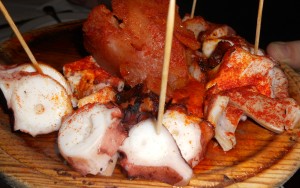 blissfully beaten octopus Luckily, one of my dining companions, a Spain-obsessed food blogger who spent several years living in Portugal, had an answer. Spaniards—specifically, professional octopus chefs called pulperos—have perfected the art of tenderizing the hell out of an octopus by slamming it against firm objects until the rubbery-ness has been thoroughly beaten out of it. Apparently, somebody in the kitchen at Casa Galicia was in charge of abusing the octopus before marinating and grilling it.
(Wouldn’t you love to be dude who abuses octopuses for a living? Cute girl at cocktail party: “So, what do you do for a living?” Octopus-abuser: “I beat octopuses senseless.” Cute girl: “Oh.”)
Anyway, the octopus abuser at Casa Galicia clearly knew what he was doing. And so did the bartender and whoever wrote the wine list at Casa Galicia: the four of us shared three bottles of charmingly inexpensive Spanish wine, and then chased our meals with orujo gallego ($4 for a disturbingly large glass), Galicia’s grapey version of grappa. By the time we left, we were probably so drunk that we would have happily taken an octopus home and cuddled with it. But we were definitely far too fat and happy to even think about beating it senseless.
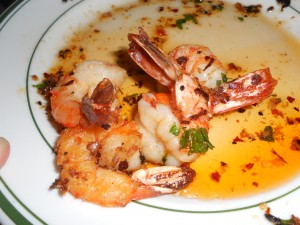 maybe the shrimp needed to be beaten senseless, too 
Casa Galicia
3709 31st Ave., Astoria, Queens
Subway: Broadway or 30th Ave. (N, Q trains)
|
|
|
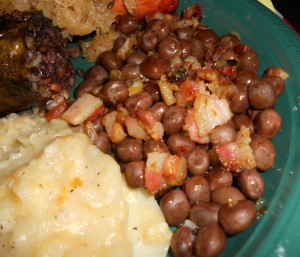 peas are much more fun when they're topped with bacon and named after a type of fat Normally, peas are healthy vegetables. They’re green and perky, and your mom probably forced you to eat them when you were a kid. I like peas and would eat them more often… except for the fact they’re good for your health. That takes all the fun out of them.
So it takes a rare stroke of genius to turn healthy, perky peas into a fun, greasy, fatty, delicious holiday dish. Luckily, the Baltic nation of Latvia seems to have no shortage of kitchen geniuses: Latvians use a pea called a marrowfat pea—which, by itself, is awesome, since it contains the word “fat,” and fat almost always tastes good. And then they top the marrowfat pea with bacon. A fat pea with bacon? I love this country.
I’ll admit that I’ve been internet-stalking the NYC Latvian community for the past few months, hoping to find a food-friendly event, preferably featuring bacon-topped marrowfat peas. And I lucked out: every winter, the NYC Latvians host a Christmas market at the Daugavas Vanagi House (DV House) in the Bronx. On the ground floor, friendly Latvian vendors offer an array of imported Latvian chocolate, Latvian baked goods, homemade Latvian sauerkraut, Latvian Christmas CDs, and some absolutely stunning handicrafts made by Latvian artisans. Downstairs, the DV House’s cozy bar hosts a traditional Christmas meal. You know, the kind that gives you a jolly, happy, Santa Claus belly.
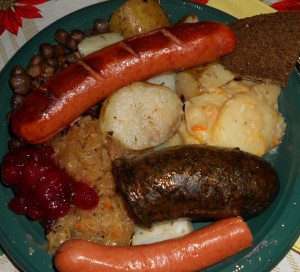 shhhh... don't tell my cardiologist Like Latvia itself, the DV House food table was relatively small, but definitely mighty. There were four varieties of pig, including three types of sausage and some diced bacon, intended as a topping for the marrowfat peas. The blood sausage—barley and herbs, mixed with pig’s blood and stuffed into a sausage casing—was particularly delicious, and resembled a hearty, not-very-fried version of Puerto Rican morcilla.
You can never really go wrong with pig, but the non-pig side dishes were equally stellar. Our Latvian friends served two different potato dishes, some homemade Latvian sauerkraut, and a fantastic dark rye bread, similar to the stuff served in our favorite Estonian drunk tank social club. Even the cranberry sauce—spiked with orange rind and orange liqueur—was outstanding. And the peas, of course, were phenomenal: pleasantly firm grey peas, topped with enough bacon to make me squeal like a happy pig. And the whole plate cost a mere $15.
 eat enough of this, and you'll have plenty of extra fat in your marrow... or hips or ass or whatever And just in case the sausage and potatoes and marrowfat peas didn’t already add enough fat to our proverbial marrow… there was an amazing dessert table, featuring $1 slices of a gently sweetened apple cake, which reminded me of the stuff my Ukrainian grandmother (and Russian-Ukrainian-American mother) used to make. The cranberry strudel was also spectacular: unusually doughy and not overly sweet, with a gentle dusting of powdered sugar. And Latvian beer also helps put a little bit of extra fat on your marrow; a jumbo bottle of Aldaris—one of Latvia’s many world-class beers—was a steal for $3.
And I mean no disrespect to any other nationality, but the NYC Latvians are pretty awesome—and that’s not just the beer talking. The small bar area at DV House comfortably fits only a few dozen patrons… and nearly every one approached our table at some point to introduce themselves and offer holiday greetings to our motley group of non-Latvians. The best line of the day was delivered by a friendly Latvian gentleman who stopped by to say hello: “This is heavy food, just for special occasions. You really can’t eat like this every day, or you’ll make your cardiologist mad. Merry Christmas, everybody!”
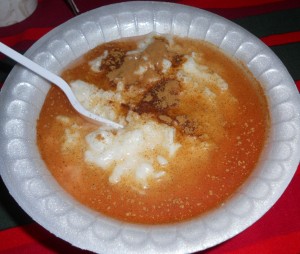 hear that? that's the sound of a porky soul crying And just to make my cardiologist even angrier, I went straight to another holiday feeding festival immediately after leaving the DV House. As luck would have it, the Finnish Lutheran Church in the West Village was having its Christmas bazaar on the exact same afternoon as the Latvian Christmas event. They weren’t serving a full meal, but they did offer traditional Finnish rice pudding, made from rice and milk, stewed forever with a little bit of salt, and then topped with a drizzle of thin raspberry juice. Cinnamon and extra sugar were optional.
And for the first time in recent memory, I left a bowl of food unfinished, and that makes a little piece of my porky soul cry. The Finnish rice pudding had been burnt, and had a charred-milk taste that I couldn’t fight my way through… though my (non-Finnish) pal Rene happily slurped down an entire bowl in about 30 seconds. He’s cooler than I am.
Despite the rice pudding disappointment, all was not lost. I went upstairs to the Finnish bake sale, and bought a massive kääretorttu roll—a thick log of mildly chocolaty dough, stuffed with raspberry jam. And I ate the whole thing. That should put some extra fat in my marrow, right?
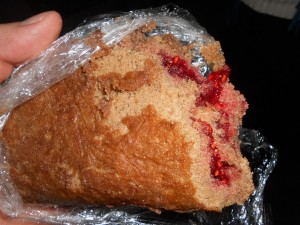 eff you, cardiologist DV House Latvian Christmas Market
Held December 3, 2011
115 West 183rd Street, Bronx
Subway: 183rd Street (4 train)
Finnish Lutheran Church Christmas Bazaar
Held December 3, 2011
81-83 Christopher Street, Manhattan
Subway: Christopher Street-Sheridan Sq. (1, 2 trains)
|
|
View My Favs!
Search This Blog
Food By Region
|




































